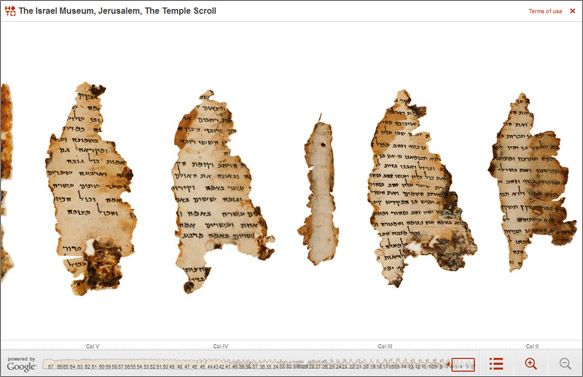The Temple Scroll
The Temple Scrolla (11Q19) was almost certainly discovered in 1956 in Cave 11, located about two kilometers north of Khirbet Qumran. The manuscript is written in Hebrew in the square Herodian script of the late Second Temple Period (the first half of the first century CE), on extremely thin animal skin (one-tenth of a millimeter), making it the thinnest parchment scroll ever found in the caves of Qumran. Two other copies of the same composition have also come to light: one in Cave 11 (Temple Scrollb [11Q20]), and another (possibly a fragmentary copy of the last part of the work) in Cave 4 (4QTemple Scrollb [4Q524]). Most scholars believe that all three manuscripts are copies of an original work composed in the Land of Israel in the second half of the second century BCE (after 120 BCE, perhaps during the rule of John Hyrcanus I).
The Temple Scrolla consists of 18 sheets of parchment, each of which has three or four columns of text. The scroll's total length is 8.146 meters; it is thus the largest scroll ever discovered in the Qumran caves. Its second half – the inner portion of the scroll – is better preserved than the first.
The work claims to provide the details of God's instructions (to Moses?) in regard to the construction and operation of the Temple. It was evidently supposed to be a kind of "new Book of Moses," which systematically combines the laws of the Temple and the sacrifices (mainly from the books of Exodus, Leviticus, and Numbers) with a new version of these laws as articulated in Deuteronomy chapters 12–23.
The Temple compound, as described in the scroll, was to be arranged in three concentric square courts, meant to resemble the camp of the Israelites in the desert. Just as the Tabernacle stood at the center of the Israelite camp, so too the utopian Temple was to stand at the center of the inner court, with the altar for burnt offerings and other objects near it, radiating its holiness to the whole of the Jewish People and the Land of Israel, as the Tabernacle did in the time of the Israelites' wandering in the desert.
A central question relates to the social provenance of this work: While the scroll shares many features in common with the other sectarian works discovered in the caves near Qumran, several representative expressions, such as the phrase "Sons of Light," and concepts, such as the belief in predestination, are lacking. Many scholars still attribute the Temple Scroll to the isolated community living at Qumran. But others reject any connection with the Qumran community, affirming that the work originated in certain priestly (possible Zadokite) circles, and that the scroll was hidden in the cave by priestly Zealots during their flight from Jerusalem, before its destruction by the Romans in 70 CE.
